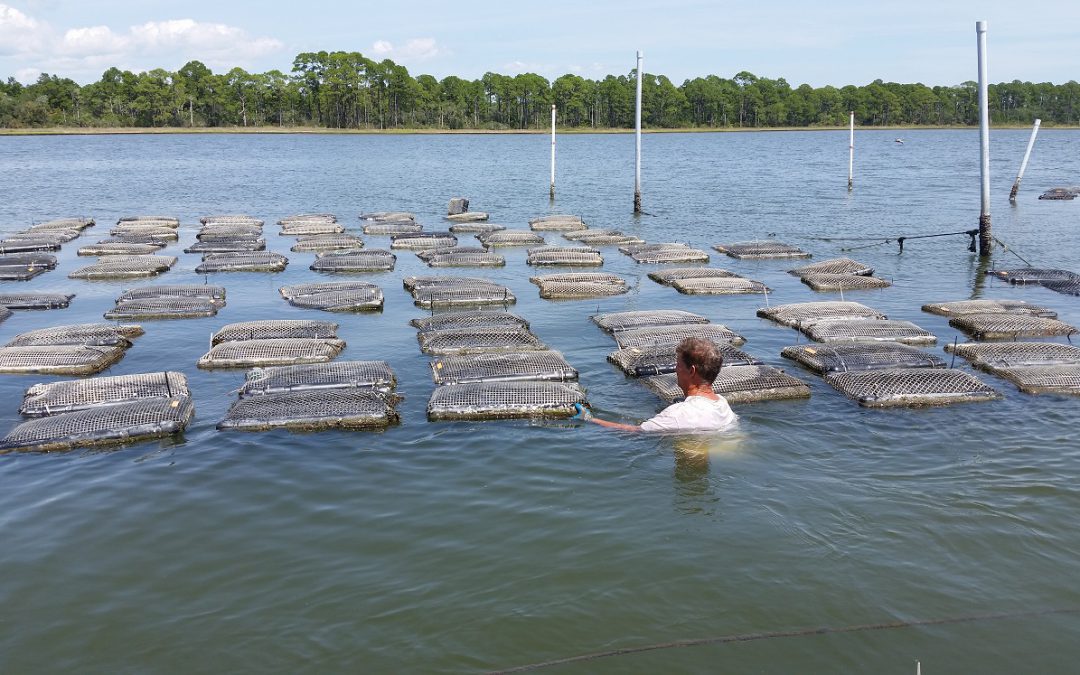
by Erik Lovestrand | Sep 25, 2020
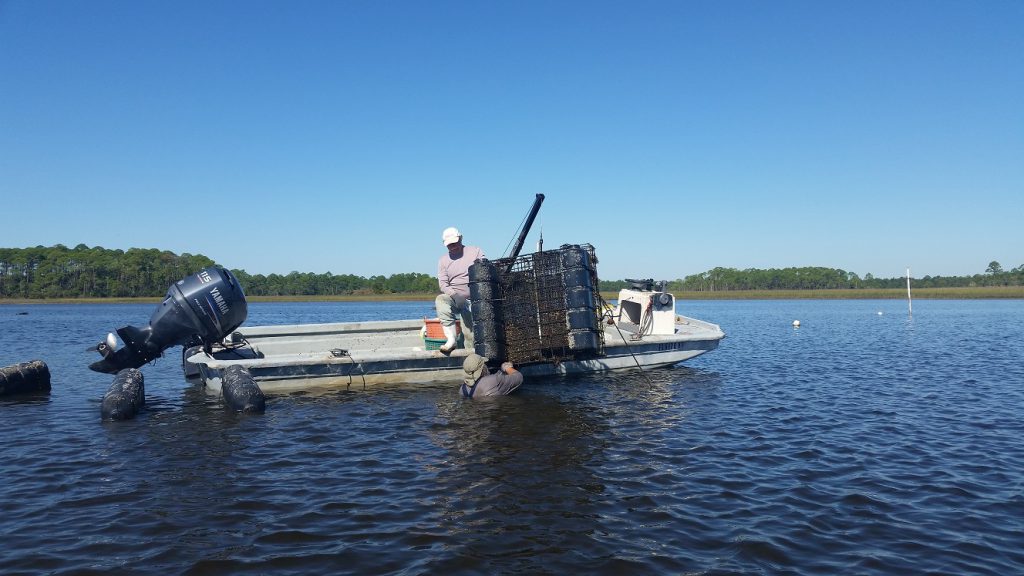
Hard work and perseverance are a must for oyster farmers.
On September 17, 2020, President Trump and US Secretary of Agriculture, Sonny Perdue, announced a second phase of an important program assisting America’s farmers. The Coronavirus Food Assistance Program (CFAP 1) was originally announced in April 2020 and now CFAP 2 will provide up to an additional $40 billion in support, along with adding more than 40 specialty crops not previously covered under CFAP 1.
This will be welcome news for many Panhandle farmers; particularly the ones that conduct their “chores” in our Panhandle bays and bayous by producing aquacultured oysters and clams. Losses in sales of molluscan shellfish were not covered under CFAP 1 because they were eligible for some assistance under the CARES Act (Coronavirus Aid, Relief, and Economic Security). However, many local growers were not able to qualify under the CARES Act for various reasons and are in serious need of assistance. When restaurants and bars were forced to close during the pandemic, sales of fresh oysters and clams basically came to a standstill overnight. Many creative efforts at direct marketing to customers and other avenues to move these time-sensitive products have been undertaken but sales are still far from what they were in 2019, leaving many growers with bills to pay and a significantly reduced bottom line.
Applications for CFAP 2 will be accepted by the USDA from September 21 through December 11, 2020. Payments will be based on 2019 sales, excepting new farmers who had no sales in 2019. Their calculations will be based on 2020 sales up to the point of application. The percent-payment-factor will be figured on a sliding scale, depending on amount of sales; ranging from 10.6% for sales below $50,000 to 8.8% for sales over $1 million.
The USDA has done a very good job of laying out information regarding the program on their website (here) and also provide assistance through their local Farm Service Agency offices around the state. Assistance with applications is available on line at this link. Two of the counties that have a significant and growing oyster aquaculture industry in the mid-Panhandle are Wakulla and Franklin. The FSA office for Wakulla County is in Monticello and can be called at (850) 997-2072 ext 2, or email Melissa Rodgers at melissa.rodgers@usda.gov. Growers in Franklin County can reach their FSA office in Blountstown at (850) 674-8388 ext 2, or email Brent Reitmeier at brent.reitmeier@usda.gov.
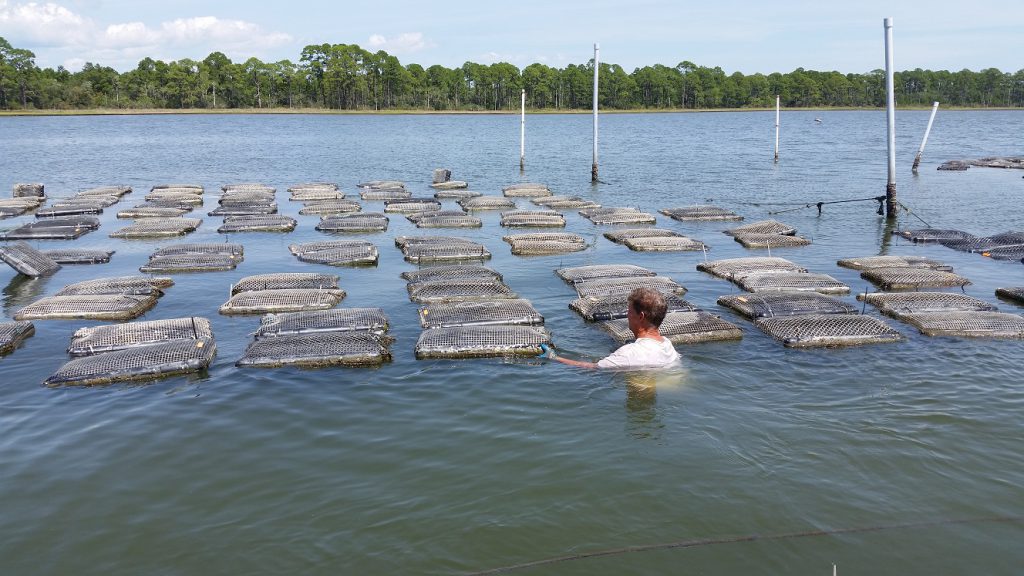
Growing oysters in floating bags requires getting wet, alot
With the plethora of confusing acronyms flying around in our present day, CFAP is one worth paying attention to. Why? Because it is providing targeted assistance to a segment of our US economy we should all stand behind. Agriculture is a critical component of all of our lives each and every day. If you have a chance to thank a farmer for what they do, or a legislator for moving this effort forward, or an industry support group that provided the data the legislator needed; don’t miss the opportunity. The hard-working men and woman who produce our food supply, including great, locally grown fresh seafood, deserve it.
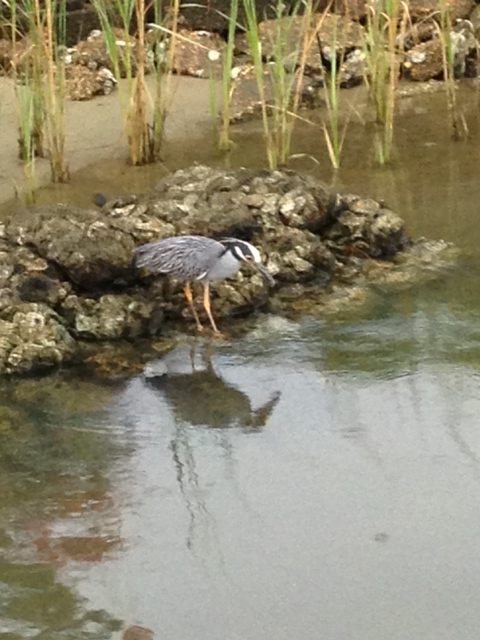
by Rick O'Connor | Apr 18, 2019
Oysters are like snakes… you either like them or you hate them. You rarely hear someone say – “yea, their okay”. It’s either I can’t get enough of them, or they are the most disgusting thing in the sea.
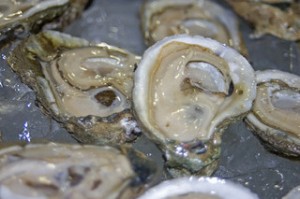
Courtesy of Florida Sea Grant
That said, they are part of our culture. Growing up here in the Florida panhandle, there were oyster houses everywhere. They are as common on menus as French fries or coleslaw. Some like them raw, some like them in gumbo or stews, others are fried oyster fans. But whether you eat them or not, you are aware of them. They are part of being in the northern Gulf of Mexico.
In recent decades the historic oyster beds that supported so many families over the years have declined in production. There are a variety of stressors triggering this. Increased sedimentation, decreased salinity, overharvesting, not returning old shell to produce new reefs, and many more. The capitol of northwest Florida’s oyster coast is Apalachicola. Many are aware of the decline of harvest there. Certainly, impacted by the “water wars” between our state and Georgia, there are other reasons why this fishery has declined. I had a recent conversation with a local in Apalachicola who mentioned they had one of their worst harvest on record this past year. Things are really bad there.
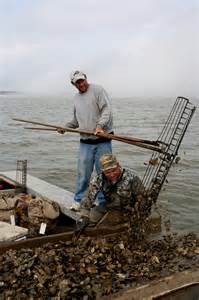
An oysterman uses his 11 foot long tongs to collect oysters from the bottom of Apalachicola Bay
Photo: Sea Grant
Despite the loss of oysters and oyster habitat, there has not been a decline in the demand for them at local restaurants. There have been efforts by Florida Sea Grant and others to help restore the historic beds, improve water quality, and assist some with the culture of oysters in the panhandle.
Enter the Bream Fisherman’s Association of Pensacola.
This group has been together for a long time and have worked hard to educate and monitor our local waterways. In 2018 they worked with a local oyster grower and the University of West Florida’s Center for Environmental Diagnostics and Bioremediation to develop an oyster garden project called Project Oyster Pensacola. Volunteers were recruited to purchase needed supplies and grow young oysters in cages hanging from their docks. Participants lived on Perdido, Blackwater, East, and Escambia Bays. Bayous Texar, and Grande. As well as Big Lagoon and Santa Rosa Sound. The small, young oysters (spat) were provided by the Pensacola Bay Oyster Company. The volunteers would measure spat growth over an eight-month period beginning in the spring of 2018. In addition, they collected data on temperature, salinity, and dissolved oxygen at their location.
After the first year, the data suggests where the salinity was higher, the oysters grew better. Actually, low salinity proved to be lethal to many of them. This is a bit concerning when considering the increase rainfall our community has witnessed over the last two years. Despite an interest in doing so, the volunteers were not allowed to keep their oysters for consumption. Permits required that the oysters be placed on permitted living shoreline projects throughout the Pensacola Bay area.
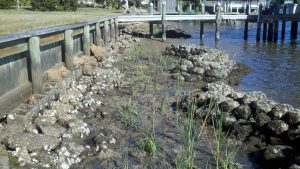
Oyster bags used in a bulkhead restoration project.
Photo: Florida Department of Environmental Protection
We all know how important oysters are to the commercial seafood industry, but it turns out they are as important to the overall health to the bays ecology. A single oyster has been reported to filter as much as 50 gallons of seawater an hour. This removes sediments and provides improved water clarity for the growth of seagrasses. It has been estimated that seagrasses are vital to at least 80% of the commercially important seafood species. It is well known that seagrasses and salt marshes are full of life. However, studies show that biodiversity and biological production are actually higher in oyster reefs. Again, supporting a booming local recreational fishing industry.
This project proved to be very interesting in it’s first year. BFA will be publishing a final report soon and plan to do a second round. For the oyster lovers in the area, increasing local oysters would be nothing short of wonderful.
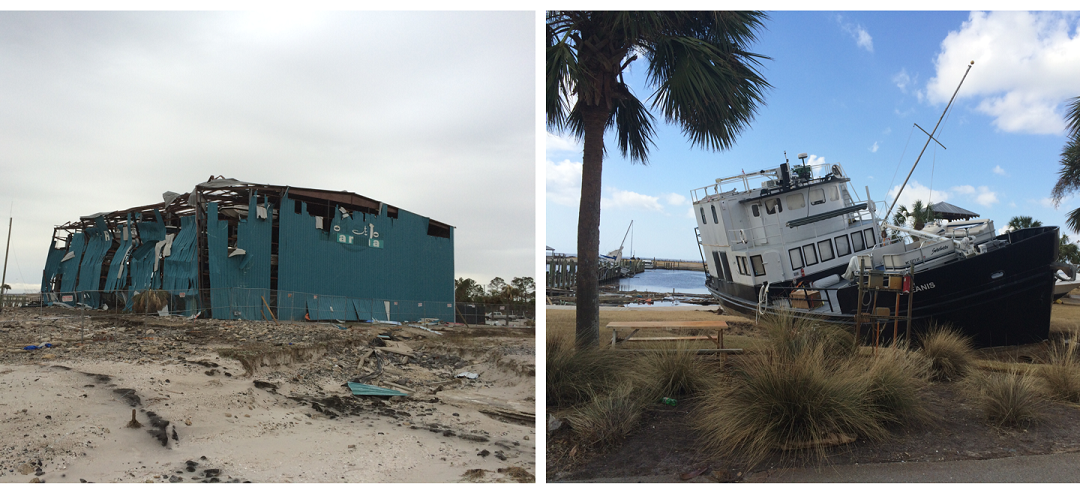
by Erik Lovestrand | Nov 26, 2018
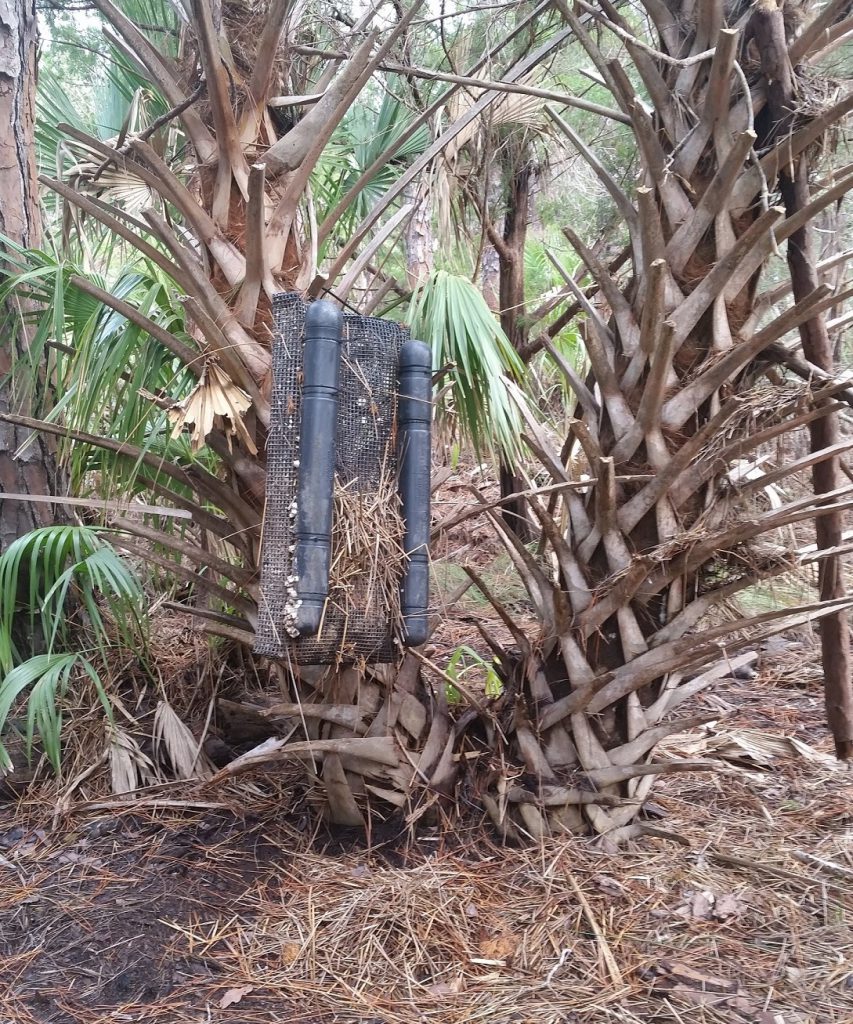
Oyster grow bag left hanging by Michael’s storm surge.
Erik Lovestrand, UF/IFAS Franklin County Extension
It may be a long time before the memories of Hurricane Michael begin to fade in the mind’s eye for residents of the Florida Panhandle. A record-breaking tropical cyclone in many respects, Michael caught a lot of people in the region off guard as it continued to gain strength on its rapid path through the Northern Gulf of Mexico. When many people went to bed the night before landfall, they had no idea what terrifying news would greet them upon hearing that a still-strengthening category 4 hurricane was about to rumble ashore.
It was not long after the wind slackened that folks began looking around and realizing the devastation left behind. Cotton crops in the path of the storm in North Florida and South Georgia suffered near 100% losses. Peanut crops were also severely impacted just at the time that harvest was beginning. The estimated damage to timber harvests alone were coming in around 1.3 billion dollars for Florida as virtually entire forests had been leveled. Even more damage was realized near the coastline where storm surge across the region ranged from 8 to 14 feet above normal water levels; smashing or flooding structures near the coast and carving new inlets across St. Joseph Peninsula near Cape San Blas.
Another industry that took a hard hit in much of the area was the seafood industry; everything from the producers to the dealers, processors, retail markets, restaurants, fueling and ice house facilities that service fishing vessels. Governor Scott requested a fisheries disaster declaration from the Federal Government and on November 1 the Secretary of the Department of Commerce granted the request. This determination provides an opportunity for Congress to appropriate fishery disaster assistance for the new fiscal year, which began in October. To further facilitate recovery efforts in Florida and beyond, the Department of Commerce can look to the Economic Development Administration, which spearheads the Federal government’s efforts to deliver economic assistance and support long-term growth after natural disasters.
Oyster growers in the region who had equipment and a crop of shellfish in the water took some losses as well. For those who were able to scramble to their leases before the storm and sink their floating baskets or cages to the bay bottoms, losses of gear were minimal as storm waves above the submerged gear had less impact. Gear that was unable to be submerged was more prone to break loose and drift away. However, even the growers that sunk gear experienced some significant oyster mortality due to sediments from churned up water smothering the shellfish in a layer of mud. Shellfish leases in Alligator Harbor were dealt another blow by an incredible field of debris that was washed off Alligator Point and blown through the lease area. Everything from boats to large sections of docks, structural walls, refrigerators and freezers was in the mix. These items were caught up in oyster long-lines and broke some while pulling up anchor poles on others, leaving quite a mess for growers to untangle.
Marinas, docks and vessels were also not immune to Hurricane Michael’s wrath in Gulf and Bay Counties. Government agencies estimate the number of damaged vessels in both Gulf and Bay counties to exceed 400. It will take some time for charter boat and commercial fishing operations to rebound. Scallop restoration projects in both St. Joseph Bay and St. Andrews Bay have suffered setbacks, as well. The hurricane has not only devastated coastal Gulf county economically and ecologically, but also geographically. There are two sizable inlets that have now been carved into the St. Joseph Peninsula. T.H. Stone State Park is closed until further notice.
Overall, the impacts from this storm will take a long time to recover from for many segments of our regional economy. Lessons learned by industries as well as individuals should improve our chances to reduce the loss of life and property in the future. The name of the game is “resiliency,” both in the spirit of the people who call this place home and in the way we learn to better adapt to what Mother Nature throws at us. Hang in there. Day by day.
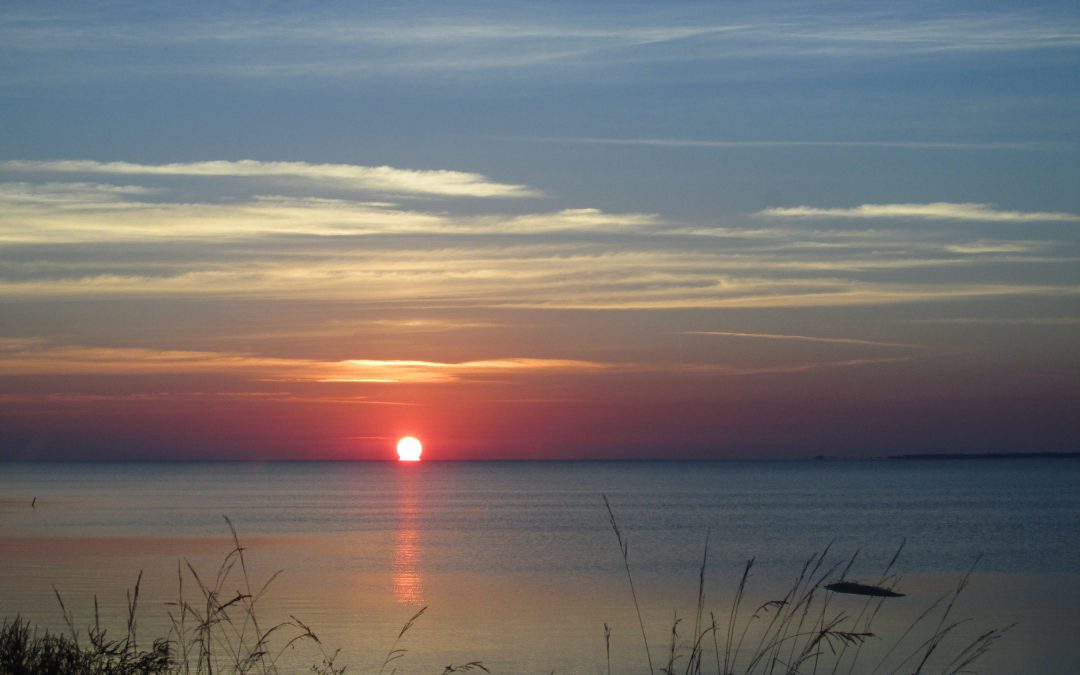
by Erik Lovestrand | Aug 3, 2018
If you have not seen the news yet, the US Supreme Court provided a ruling on June 27, 2018 regarding the decades-long conflict between Florida and Georgia over water use in the Apalachicola-Chattahoochee-Flint tri-state river basin. Guess what; the battle continues. Following the previous findings of the court-appointed Special Master and his recommendation to deny Florida relief in the dispute, there were many disappointed people south of the border between the two states. The recent decision to remand the case back to the Special Master for further consideration has taken many by surprise; happy surprise south of the border and not so happy as you look northward (unless you talk to the attorneys litigating the case, maybe).
The resulting decision kept Florida’s hopes alive for an equitable allocation of water resources in the basin that spans nearly 20,000 square miles of the Southeastern US. At stake, from Florida’s perspective, is the productivity and ecosystem integrity of the Apalachicola River and Bay ecosystem. For Georgia, enough water to supply its growing population and thirsty agricultural interests in the Flint River Basin south of Atlanta.
The Court’s 5–4 decision, found that the Special Master had applied too high a standard regarding “harm and redressability” for Florida’s claims. They ordered the case to be reheard so that appropriate considerations could be given to Florida’s arguments. “The amount of extra water that reaches the Apalachicola may significantly redress the economic and ecological harm that Florida has suffered,” said Justice Breyer, who was joined by Chief Justice John Roberts and Justices Anthony Kennedy, Ruth Bader Ginsburg and Sonya Sotomayor. “Further findings, however, are needed.”
The Court’s opinion does not actually outline any specific solutions for the water battle, and it in no way guarantees a win for Florida, but it does keep the legal challenge alive – along with the hope of better days for Florida’s oyster industry, which has suffered a major fisheries collapse that began around 2012. Visit this link if you would like to read the syllabus, as well as the full opinion of the High Court.
We should all consider the magnitude of the importance of the Apalachicola River and Bay for our region, due to its connection to the larger Gulf of Mexico. Estuaries like this are crucial links in the life-stages of countless marine organisms, including many we depend on for food and recreation. Blue crabs migrate tremendous distances to spawn in our near shore estuaries. Their young then disperse to populate large areas of coastline. Post-larval shrimp move into our estuaries to grow up after being spawned offshore. Later they swim out as adults to begin the cycle again. It is no wonder the shorelines of our Florida estuaries are dotted with prehistoric shell middens from peoples who thrived near these resource-rich ecosystems. Who knows if the Apalachicola Bay will ever recover to the productivity of its glory days, when a hard-working person could harvest 20 bags of oysters in a day? Regardless, we should all be thankful for what Apalachicola Bay has meant to so many generations of people over such a wide expanse of our Northern Gulf of Mexico coastline. Take just a moment to think about it, please.
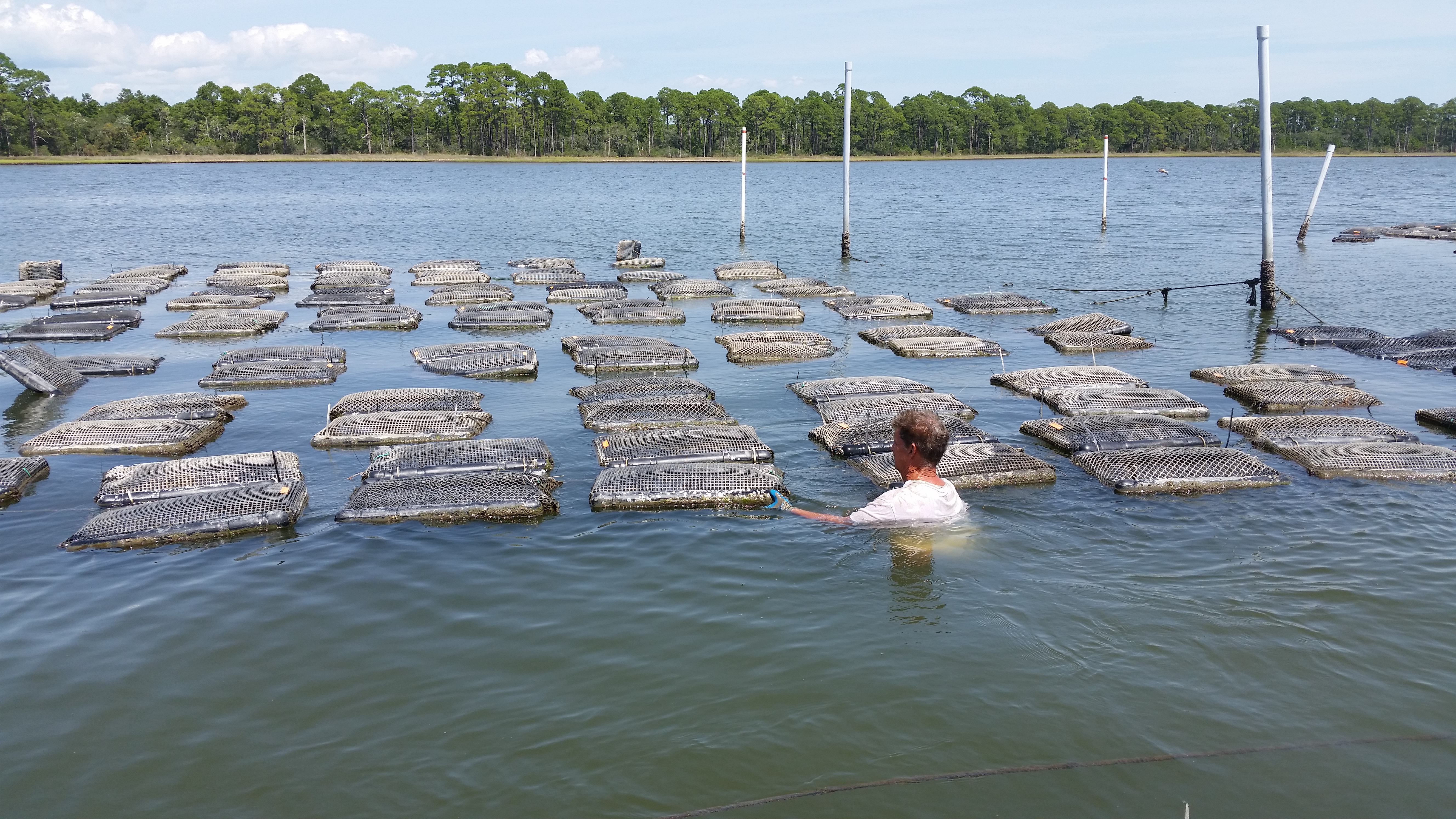
by Erik Lovestrand | Feb 2, 2018
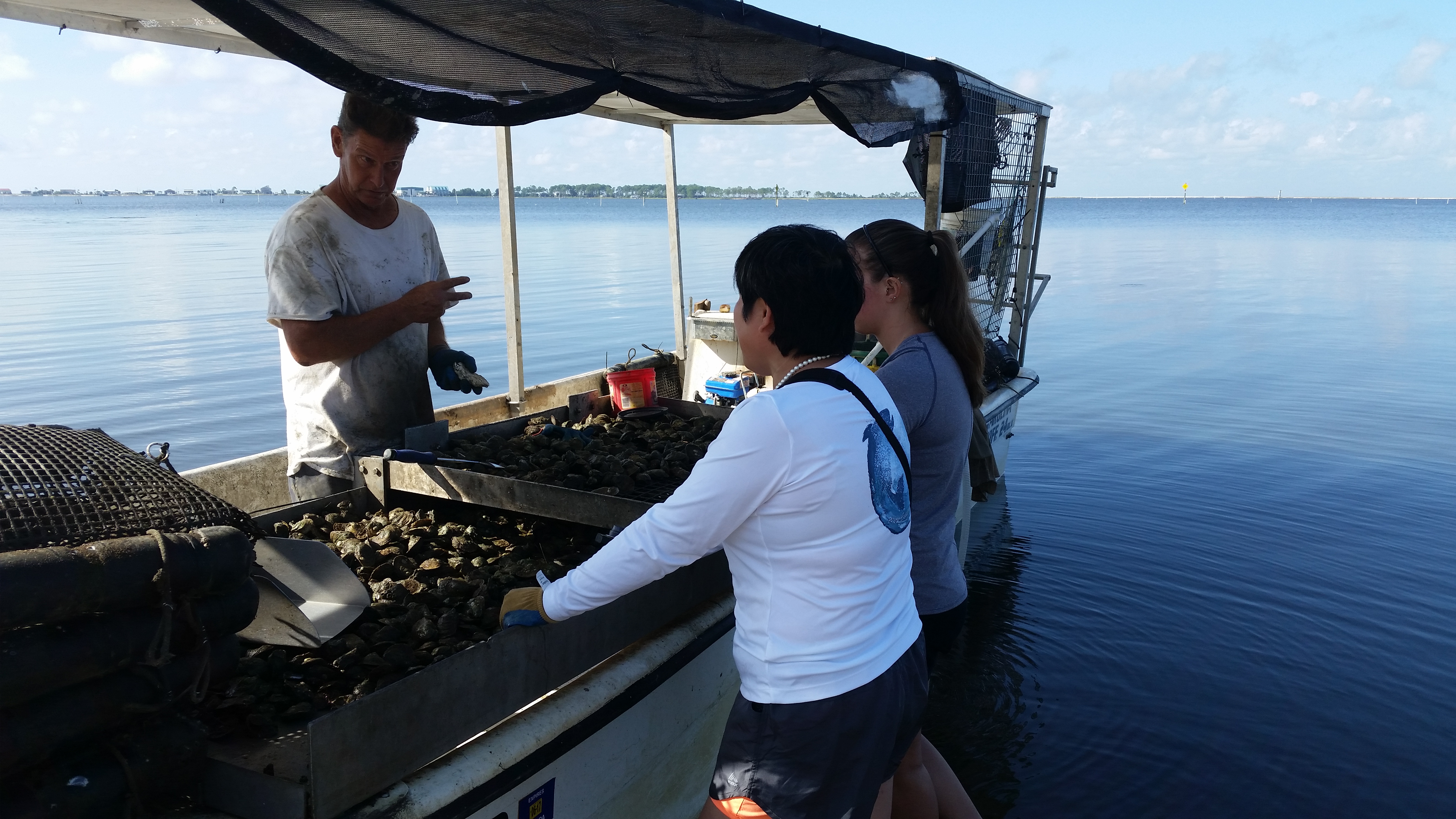
Sorting and re-caging take place on-site at the lease
Photo: Erik Lovestrand
There are a number of parallels than can be drawn between shellfish farming and traditional forms of agriculture that take place on the land. The most obvious similarities are the amount of hard work, grit and faith that are required of the farmer on land or sea. In spite of this there are many “salty” farmers in the Florida Panhandle who have mustered the faith requirement and are now putting in the hard work necessary to help build this budding industry in the Southeastern U.S.
Market demand for quality oysters has continued to outstrip available supplies for several years of late. This has been due in part to better marketing strategies employed by growers as well as clientele becoming aware of the health benefits of fresh oysters; a great supply of important vitamins and minerals, including vitamin C and B vitamins, zinc, selenium and iron. However, supply/demand ratios are not the only important factor in developing a thriving oyster aquaculture industry. Also required, is the necessary infrastructure to support the grower’s equipment needs, enough sources of baby oyster “seed”, a reliable refrigerated transportation network for live shellfish, and the support of regulatory agencies in making water leases available in suitable growing areas.
Fortunately, the stars seem to be aligning for many of these industry-growth necessities and the business of oyster farming is gaining a firmer foundation to build upon. One of the important milestones for Florida was the approval of “full-water-column” leases, which allows the use of floating oyster cages or bags. Previously, oysters were required to be grown on the bay bottom and this made them susceptible to higher levels of predation from crabs and snails and severe biofouling (barnacles and algae) on the exterior of the mesh bags. Heavy biofouling reduces the water flow through the oyster’s growing environment, thus the available food for this filter feeding bivalve.
One critical need for this industry is the availability of quality “seed” (baby oysters) to put in the growing waters. Seed oysters are supplied by hatcheries where oyster brood stocks are spawned and babies are raised to the necessary age for grower needs. Some growers use baby oyster larvae that have not settled and attached yet. These “eyed larvae” are put in a tank with old oyster shell and allowed to attach on the shells, which are then deployed at a lease site. Other growers use seed that has already attached to a small particle of crushed shell and are sold as individual oysters to be placed in grow-out bags or cages. The more recent development of oyster stocks with 3 sets of chromosomes (triploids) have provided growers with an oyster that gets to market size faster. Triploid oysters are infertile and do not use energy for spawning, thereby putting more energy into shell and tissue growth. Federal and state laws also govern where growers can buy their seed in an effort aimed at stopping the spread of shellfish disease from one body of water to another (i.e. Atlantic to Gulf of Mexico, etc.).
Even if all of the hardware and infrastructure is in place, there is still one other factor that plays a significant role in whether an oyster farmer will be successful. Just like the dairy farmer, the cattle rancher, the cotton or peanut grower, or the blueberry producer; backbreaking labor is necessary for many stages of the production cycle. Oyster growers work their leases either bending over the gunnels of a boat or actually being in the water, lifting heavy bags or cages of shellfish, sorting by size, re-caging, and moving lots of materials to and from the lease area. True grit and a dogged determination to stay on top of things, regardless of unpleasant conditions, are vital to raising a successful crop of oysters. And by the way, don’t forget that Mother Nature will have the final word. As all farmers know, they are required to be a good listener when she speaks.
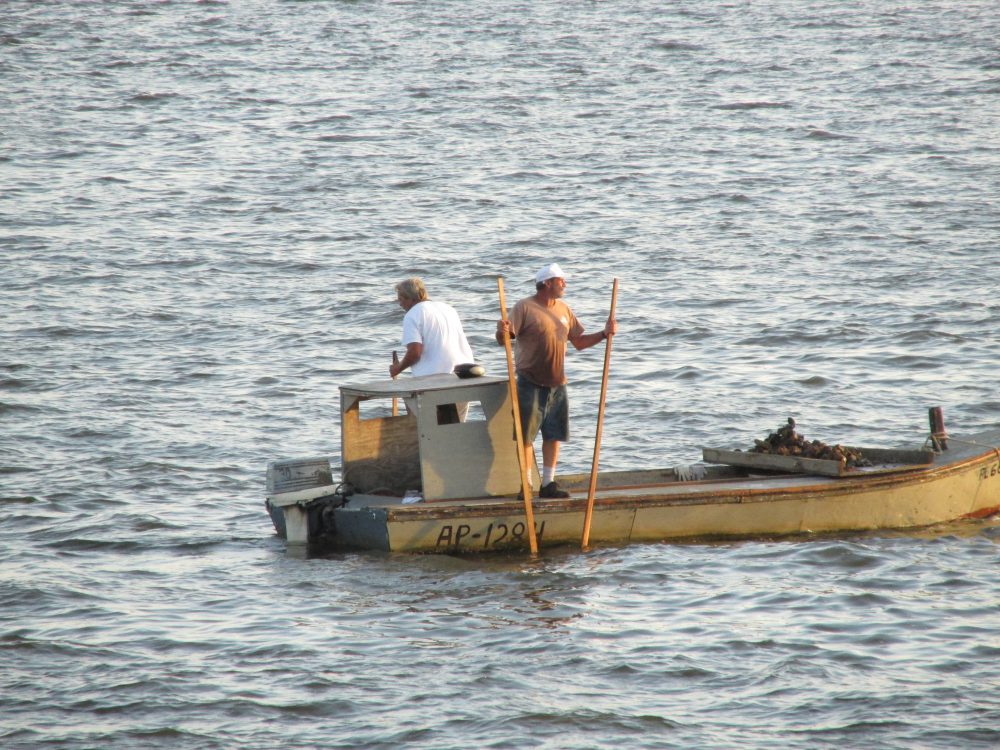
by Rick O'Connor | Feb 18, 2017
In his 137-page report to the U.S. Supreme Court published on Valentine’s Day, a Special Master appointed to oversee the case has stated, “Because Florida has not met its burden, I recommend that the court deny Florida’s request for relief.” This may not be the final word on the matter but it does sound like the “bottom line” as the highest court in the land will lean heavy on his recommendation when they rule on the case in the days to come. So, will this be the end of the decades-long battle over water rights in the Apalachicola-Chattahoochee-Flint River Basin? Considering the magnitude of what is at stake when it comes to this “Dixie-Style” water war, I seriously doubt it.
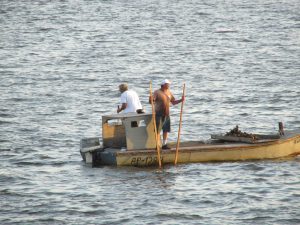
Hard working Apalachicola oystermen are finding times tougher with the “water wars” problem.
Photo: Erik Lovestrand
Florida argued for years that Georgia was illegally using water from its reservoir in Lake Lanier for unauthorized purposes according to the legislation that allowed the dam to be built in the first place. When that argument fell through during prior court rulings, the state sued claiming harm to the once prolific oyster fishery in Apalachicola Bay that has sustained a near total collapse that began in 2012. Florida contended that reduced freshwater flows tied to increased human needs upstream and sustained drought in the southeast had resulted in higher average salinities in the Bay, which added stressors (disease, parasites and predators), causing the crash.
Proponents of Florida’s case were ecstatic when the highest court in the land agreed to hear this case, following denials to do so in the past. Proponents on Georgia’s side of the case claimed that there was no proof that reduced flows had caused the crash and instead blamed poor management of the fishery for Florida’s woes.
Special Master Ralph Lancaster largely agreed with Florida’s assertions on the cause of the fishery disaster but still ruled against Florida’s request for relief saying that the evidence based on low flows during drought periods did not prove how a cap on Georgia’s water use during other times would provide the relief requested. Special Master Lancaster also hinted that Florida had made a grave mistake in not naming the Corps of Engineers as a party in this dispute. He said “Because the Corps is not a party, no decree entered by this court can mandate any change in the Corps’ operations in the basin.”
Georgia officials are breathing a sigh of relief as the economic impact to their state would have been substantial if this had not gone their way. On the other side of Lake Seminole at the State line, Florida’s resource managers still worry about what they can do to improve conditions in a struggling estuary on the Gulf Coast, once known locally as the “Oyster Capital of the World.”














